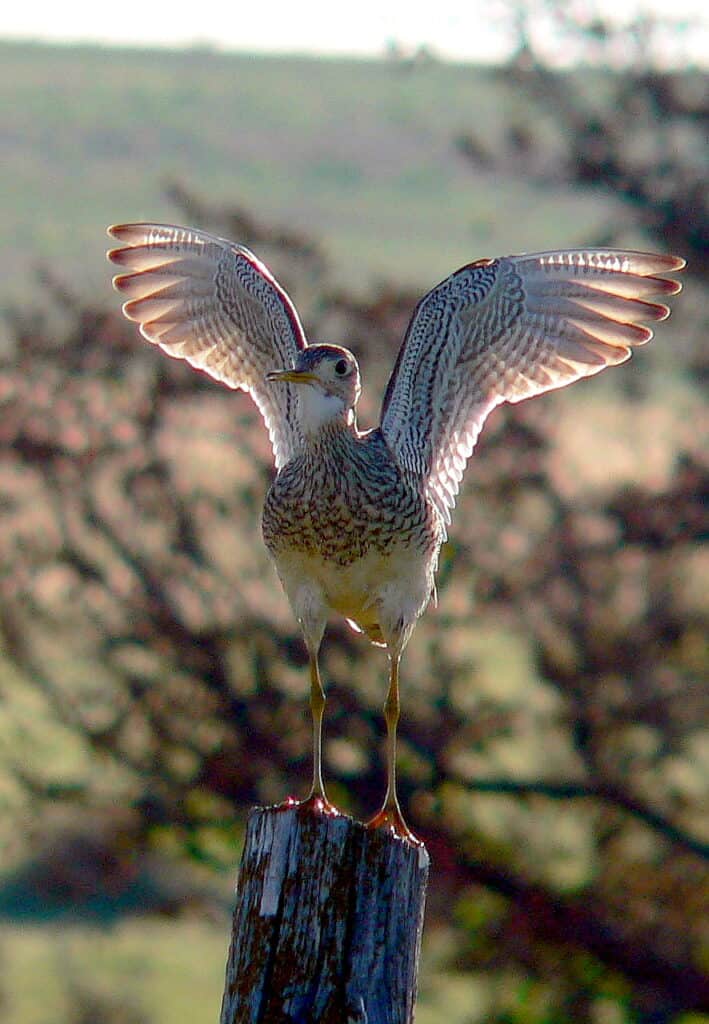They make jerky movements as they walk through the grass, searching for food.
Advertisement
Upland Sandpiper Scientific Classification
- Kingdom
- Animalia
- Phylum
- Chordata
- Class
- Aves
- Order
- Charadriiformes
- Family
- Scolopacidae
- Genus
- Bartramia
- Scientific Name
- Bartramia longicauda
Read our Complete Guide to Classification of Animals.
Upland Sandpiper Conservation Status
Upland Sandpiper Facts
- Prey
- crickets, grasshoppers, beetles, moths, flies, ants
- Main Prey
- Insects
- Name Of Young
- Peep
- Group Behavior
- Social
- Fun Fact
- They make jerky movements as they walk through the grass, searching for food.
- Estimated Population Size
- 750,000
- Biggest Threat
- Habitat loss
- Most Distinctive Feature
- Small head with large eyes
- Distinctive Feature
- Long tails, long wings
- Wingspan
- 26 inches
- Incubation Period
- 22 to 27 days
- Age Of Independence
- One month
- Age Of Fledgling
- Shortly after hatching
- Habitat
- Open country areas with tall grass
- Predators
- Birds of prey, coyotes, gulls
- Diet
- Insectivore
- Lifestyle
- Diurnal
- Type
- Bird
- Common Name
- Upland sandpiper
- Location
- North America, South America
- Average Clutch Size
- 4
- Nesting Location
- On the ground near dense vegetation
- Migratory
- 1
View all of the Upland Sandpiper images!
“These shorebirds prefer open country habitats with tall grasses, compared to the usual sandpiper coastal environments. ”
Summary
The upland sandpiper (Bartramia longicauda) is native to North and South America, where it lives in open country areas with tall grass to hide. It spends its days walking through the vegetation, picking up insects, seeds, and grains. This social bird forms monogamous bonds and lives communally most of the year. Look for their jerky movements on the ground, or flying high in the sky, making their rolling whistles. Discover all the fascinating facts about the upland sandpiper, including where they live, what they eat, and how they behave.
5 Amazing Upland Sandpiper Facts
- Upland sandpipers have a wide range, breeding as far north as Alaska and wintering as far south as Argentina.
- They have chevron-shaped markings on their sides and breasts.
- This species has unusual proportions, featuring a rotund body, a long, skinny neck, a small head, and large eyes.
- They make jerky movements as they walk through the grass, searching for food.
- Unlike most shorebirds, upland sandpipers prefer open country areas to coastlands.
Where to Find the Upland Sandpiper
Upland sandpipers live across North and South America in over 30 countries, including Canada, the United States, Mexico, Argentina, and Venezuela. They have a relatively wide range, breeding as far north as Alaska and wintering as far south as Argentina. They spend their winters in Northeastern Argentina, Uruguay, and Southern Brazil. In the United States, you will mosty find them east of the Rocky Mountains, with some small breeding populations in Oregon and Idaho. These shorebirds prefer open country habitats with tall grasses, compared to the usual sandpiper coastal environments. They have a large population in the northern Midwest of the United States.
Upland Sandpiper Nest
Males use their feet to clear a space on the ground near dense vegetation, and females make a scrape and line the inside with grasses and leaves. The nest is often hidden by overhanging grass and other plants.
Scientific Name
The upland sandpiper (Bartramia longicauda) belongs to the Charadriiformes order in the Scolopacidae family, encompassing sandpipers. It is the only member of the genus Bartramia, which commemorates the American naturalist William Bartram. Its specific name, Longicauda, is Latin for “long” and “tail.” This species is known by several older names, including upland plover and Bartram’s sandpiper.
Size, Appearance, & Behavior

The global upland sandpiper population is estimated to number 750,000 mature individuals.
©886 × 1,280 pixels, file size: 1,013 KB, MIME type: image/jpeg – License
The upland sandpiper is a large sandpiper, measuring 12 inches long and weighing six ounces, with a 26-inch wingspan. This bird is known for its unusual proportions, featuring a rotund body with a long, thin neck and a small head with large eyes. They also have a thin, straight bills, long legs, and long wings. These birds are heavily streaked with chevron-shaped markings on their sides. Their coloring is a marbling golden brown and black, with white below. These sandpipers are social year-round, forming pair bonds and feeding and nesting communally. They also migrate and groups, giving their sad, rolling whistles to each other mid-flight. They fly high and produce fluttering wingbeats.
Migration Pattern and Timing
They are long-distance migrants who travel in flocks or family groups at night. They breed in the Northern United States, Alaska, and parts of Canada. And they migrate through Central and Southeastern United States, Mexico, Central America, and Northern South America before reaching their wintering grounds in Central and Southern South America (Bolivia, Paraguay, Uruguay, and Argentina).
Diet
The upland sandpiper is primarily an insectivore who forages in fields.
What Does the Upland Sandpiper Eat?
Their diet consists of crickets, grasshoppers, beetles, moths, flies, ants, centipedes, spiders, snails, and worms. They also supplement their diet with grains and seeds. They forage by walking through grass and picking insects from the ground or vegetation. You can spot them by their jerky movements.
Predators, Threats, and Conservation Status
The IUCN lists the upland sandpiper as LC or “least concern.” Due to its extensive range and very large, increasing population, this species does not qualify for “threatened” status. The biggest threat to this sandpiper is the loss of habitat. They require large expanses of grassland and are vulnerable to habitat fragmentation and total loss. They may also suffer from the future effects of climate change, such as spring heat waves and wildfires.
What Eats the Upland Sandpiper?
The primary predators of upland sandpipers include birds of prey like hawks and owls and mammalian predators like coyotes. Their nests are especially vulnerable to predation from other birds like gulls and raptors. They conceal their nests in tall grass and weeds and use threatening postures and distraction displays to drive away intruders.
Reproduction, Young, and Molting
Not much is known about their mating system, but researchers believe they form monogamous pair bonds. Their breeding season is early to late summer, and they nest in loose colonies. Females lay four pale pink eggs, and both sexes incubate for 22 to 27 days. The young fledge the nest shortly after hatching and become independent around 30 days when they can fly. These birds live an average of four years but can live up to eight years.
Population
The global upland sandpiper population is estimated to number 750,000 mature individuals. This species has been stable since 1970, and short-term trends suggest their numbers are increasing by 13% over the past three generations.
Related Animals:
View all 16 animals that start with UUpland Sandpiper FAQs (Frequently Asked Questions)
Are upland sandpipers endangered?
The IUCN lists the upland sandpiper as LC or “least concern.” The biggest threat to this sandpiper is the loss of habitat.
Where can I find the upland sandpiper?
They live in North and South America, inhabiting open country areas with tall grass. They have a large population in the northern Midwest of the United States.
What sound does an upland sandpiper make?
They produce mournful, rolling whistle calls.
Do upland sandpipers migrate?
They are long-distance migrants who breed in the Northern United States, Alaska, and parts of Canada and winter in Central and Southern South America (Bolivia, Paraguay, Uruguay, and Argentina).
What do upland sandpipers eat?
Their diet consists of crickets, grasshoppers, beetles, moths, flies, ants, centipedes, spiders, snails, and worms.
How big is an upland sandpiper?
The upland sandpiper is a large sandpiper, measuring 12 inches long and weighing six ounces, with a 26-inch wingspan.
What are upland sandpiper predators?
The primary predators of upland sandpipers include birds of prey like hawks and owls and mammalian predators like coyotes. Their nests are especially vulnerable to predation from other birds like gulls and raptors.
Thank you for reading! Have some feedback for us? Contact the AZ Animals editorial team.

















